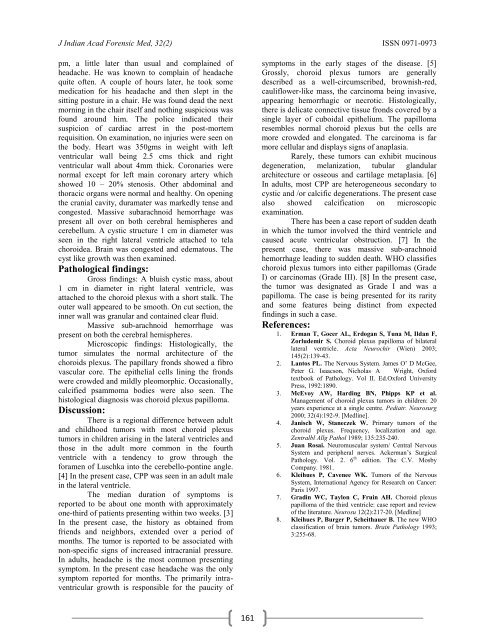jiafm, 2010-32(2) april-june. - forensic medicine
jiafm, 2010-32(2) april-june. - forensic medicine
jiafm, 2010-32(2) april-june. - forensic medicine
- No tags were found...
You also want an ePaper? Increase the reach of your titles
YUMPU automatically turns print PDFs into web optimized ePapers that Google loves.
J Indian Acad Forensic Med, <strong>32</strong>(2) ISSN 0971-0973pm, a little later than usual and complained ofheadache. He was known to complain of headachequite often. A couple of hours later, he took somemedication for his headache and then slept in thesitting posture in a chair. He was found dead the nextmorning in the chair itself and nothing suspicious wasfound around him. The police indicated theirsuspicion of cardiac arrest in the post-mortemrequisition. On examination, no injuries were seen onthe body. Heart was 350gms in weight with leftventricular wall being 2.5 cms thick and rightventricular wall about 4mm thick. Coronaries werenormal except for left main coronary artery whichshowed 10 – 20% stenosis. Other abdominal andthoracic organs were normal and healthy. On openingthe cranial cavity, duramater was markedly tense andcongested. Massive subarachnoid hemorrhage waspresent all over on both cerebral hemispheres andcerebellum. A cystic structure 1 cm in diameter wasseen in the right lateral ventricle attached to telachoroidea. Brain was congested and edematous. Thecyst like growth was then examined.Pathological findings:Gross findings: A bluish cystic mass, about1 cm in diameter in right lateral ventricle, wasattached to the choroid plexus with a short stalk. Theouter wall appeared to be smooth. On cut section, theinner wall was granular and contained clear fluid.Massive sub-arachnoid hemorrhage waspresent on both the cerebral hemispheres.Microscopic findings: Histologically, thetumor simulates the normal architecture of thechoroids plexus. The papillary fronds showed a fibrovascular core. The epithelial cells lining the frondswere crowded and mildly pleomorphic. Occasionally,calcified psammoma bodies were also seen. Thehistological diagnosis was choroid plexus papilloma.Discussion:There is a regional difference between adultand childhood tumors with most choroid plexustumors in children arising in the lateral ventricles andthose in the adult more common in the fourthventricle with a tendency to grow through theforamen of Luschka into the cerebello-pontine angle.[4] In the present case, CPP was seen in an adult malein the lateral ventricle.The median duration of symptoms isreported to be about one month with approximatelyone-third of patients presenting within two weeks. [3]In the present case, the history as obtained fromfriends and neighbors, extended over a period ofmonths. The tumor is reported to be associated withnon-specific signs of increased intracranial pressure.In adults, headache is the most common presentingsymptom. In the present case headache was the onlysymptom reported for months. The primarily intraventriculargrowth is responsible for the paucity ofsymptoms in the early stages of the disease. [5]Grossly, choroid plexus tumors are generallydescribed as a well-circumscribed, brownish-red,cauliflower-like mass, the carcinoma being invasive,appearing hemorrhagic or necrotic. Histologically,there is delicate connective tissue fronds covered by asingle layer of cuboidal epithelium. The papillomaresembles normal choroid plexus but the cells aremore crowded and elongated. The carcinoma is farmore cellular and displays signs of anaplasia.Rarely, these tumors can exhibit mucinousdegeneration, melanization, tubular glandulararchitecture or osseous and cartilage metaplasia. [6]In adults, most CPP are heterogeneous secondary tocystic and /or calcific degenerations. The present casealso showed calcification on microscopicexamination.There has been a case report of sudden deathin which the tumor involved the third ventricle andcaused acute ventricular obstruction. [7] In thepresent case, there was massive sub-arachnoidhemorrhage leading to sudden death. WHO classifieschoroid plexus tumors into either papillomas (GradeI) or carcinomas (Grade III). [8] In the present case,the tumor was designated as Grade I and was apapilloma. The case is being presented for its rarityand some features being distinct from expectedfindings in such a case.References:1. Erman T, Gocer AL, Erdogan S, Tuna M, Ildan F,Zorludemir S. Choroid plexus papilloma of bilaterallateral ventricle. Acta Neurochir (Wien) 2003;145(2):139-43.2. Lantos PL. The Nervous System. James O‟ D McGee,Peter G. Isaacson, Nicholas A Wright, Oxfordtextbook of Pathology. Vol II. Ed.Oxford UniversityPress, 1992:1890.3. McEvoy AW, Harding BN, Phipps KP et al.Management of choroid plexus tumors in children: 20years experience at a single centre. Pediatr. Neurosurg2000; <strong>32</strong>(4):192-9. [Medline].4. Janisch W, Staneczek W. Primary tumors of thechoroid plexus. Frequency, localization and age.Zentralbl Allg Pathol 1989; 135:235-240.5. Juan Rosai. Neuromuscular system/ Central NervousSystem and peripheral nerves. Ackerman‟s SurgicalPathology. Vol. 2. 6 th edition. The C.V. MosbyCompany. 1981.6. Kleihues P, Cavenee WK. Tumors of the NervousSystem, International Agency for Research on Cancer:Paris 1997.7. Gradin WC, Taylon C, Fruin AH. Choroid plexuspapilloma of the third ventricle: case report and reviewof the literature. Neurosu 12(2):217-20. [Medline]8. Kleihues P, Burger P, Scheithauer B. The new WHOclassification of brain tumors. Brain Pathology 1993;3:255-68.161



![syllabus in forensic medicine for m.b.b.s. students in india [pdf]](https://img.yumpu.com/48405011/1/190x245/syllabus-in-forensic-medicine-for-mbbs-students-in-india-pdf.jpg?quality=85)



![SPOTTING IN FORENSIC MEDICINE [pdf]](https://img.yumpu.com/45856557/1/190x245/spotting-in-forensic-medicine-pdf.jpg?quality=85)

![JAFM-33-2, April-June, 2011 [PDF] - forensic medicine](https://img.yumpu.com/43461356/1/190x245/jafm-33-2-april-june-2011-pdf-forensic-medicine.jpg?quality=85)



![JIAFM-33-4, October-December, 2011 [PDF] - forensic medicine](https://img.yumpu.com/31013278/1/190x245/jiafm-33-4-october-december-2011-pdf-forensic-medicine.jpg?quality=85)


